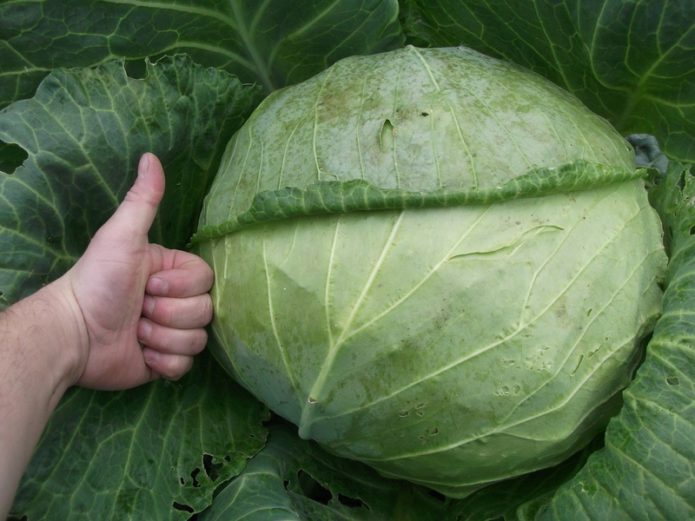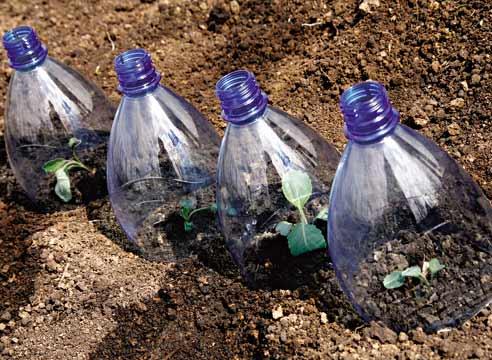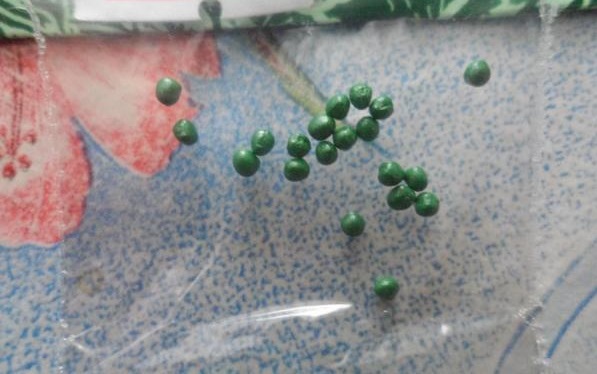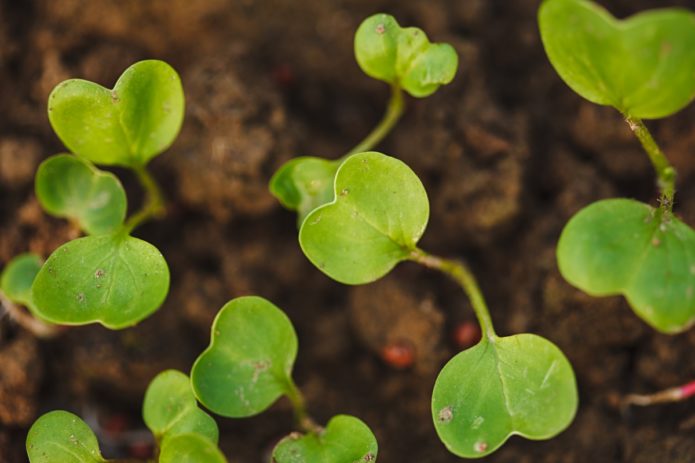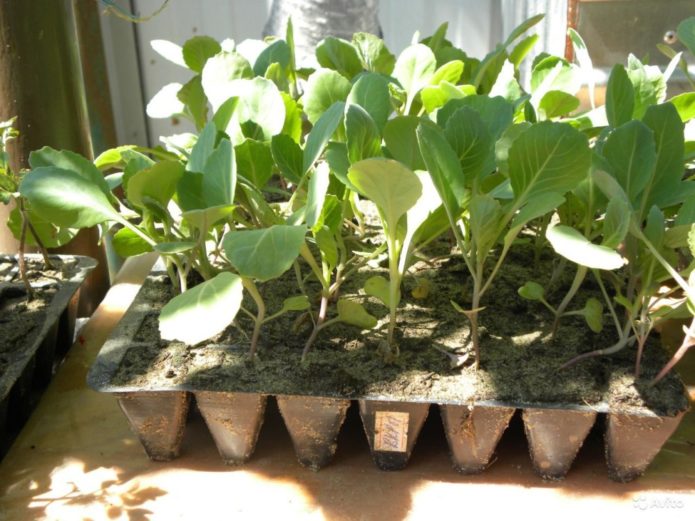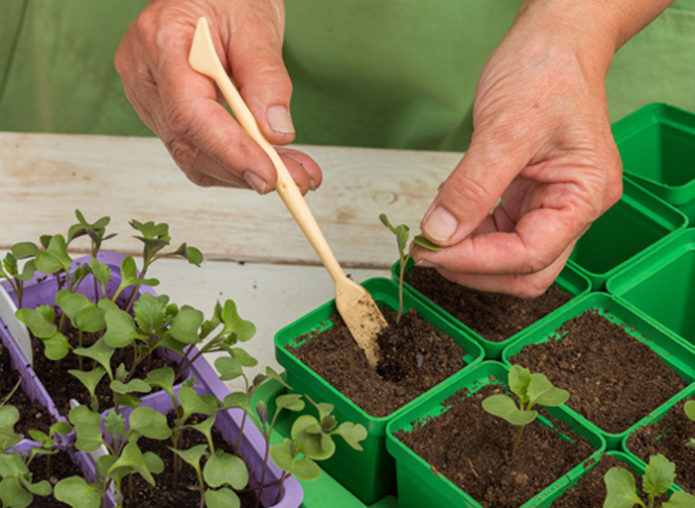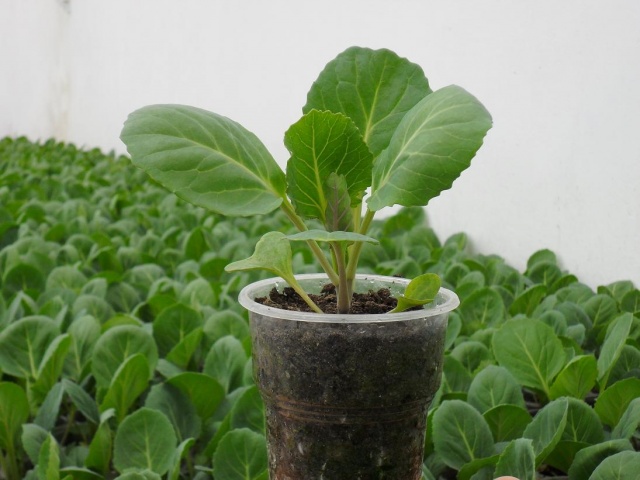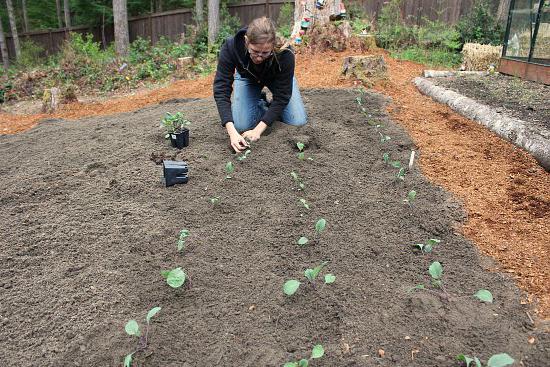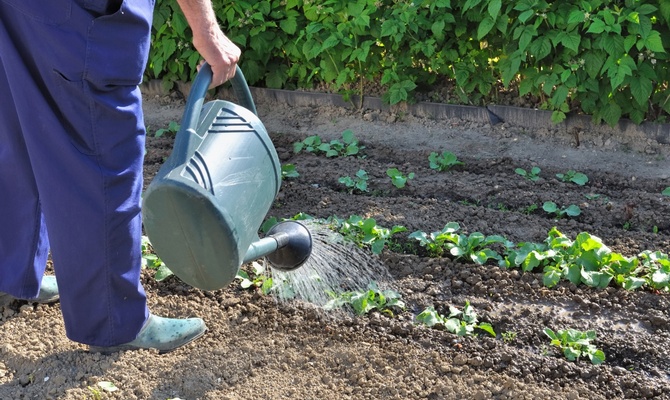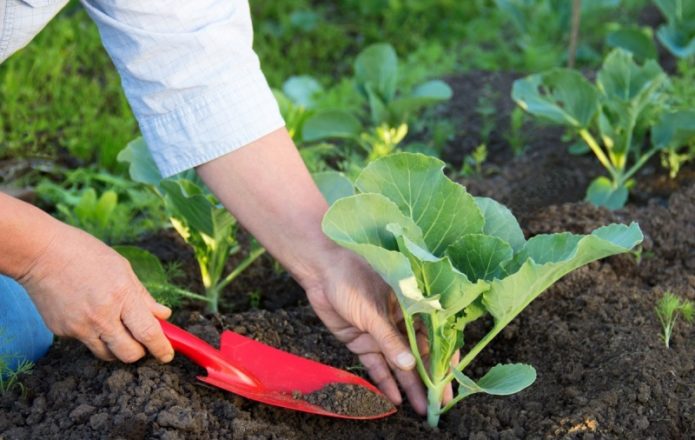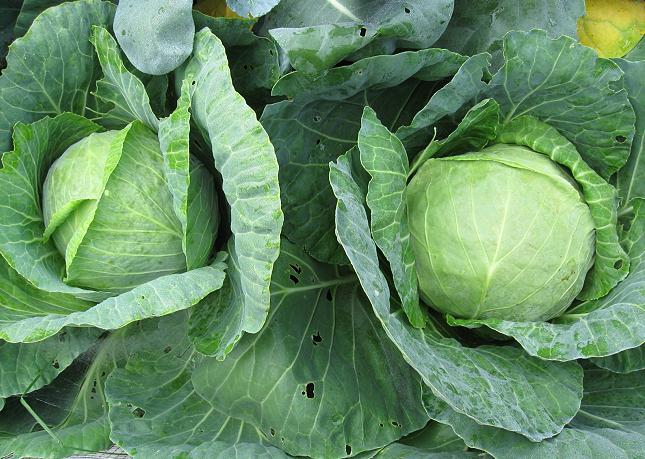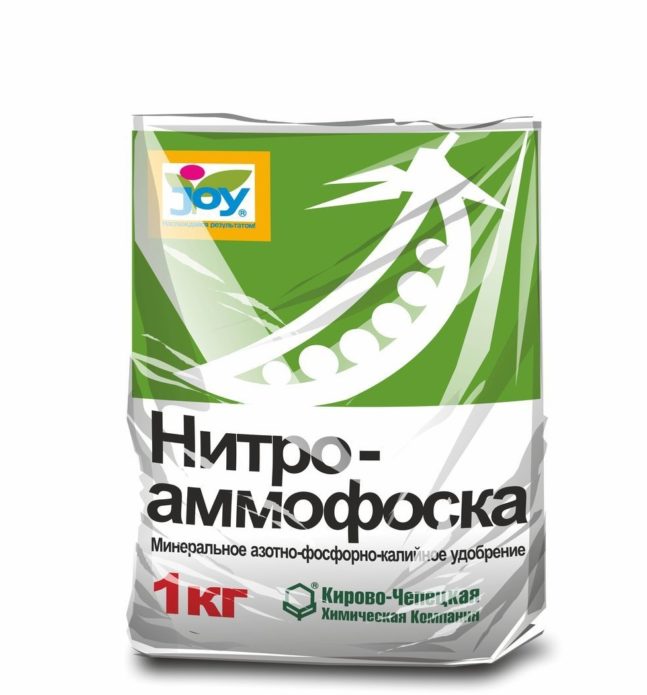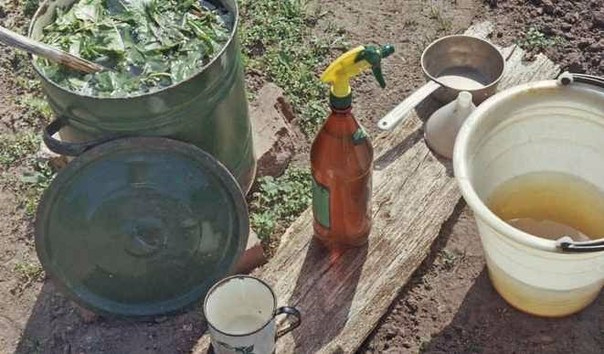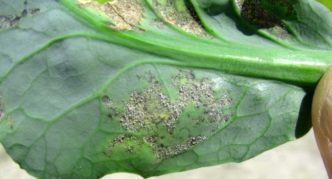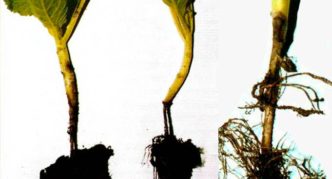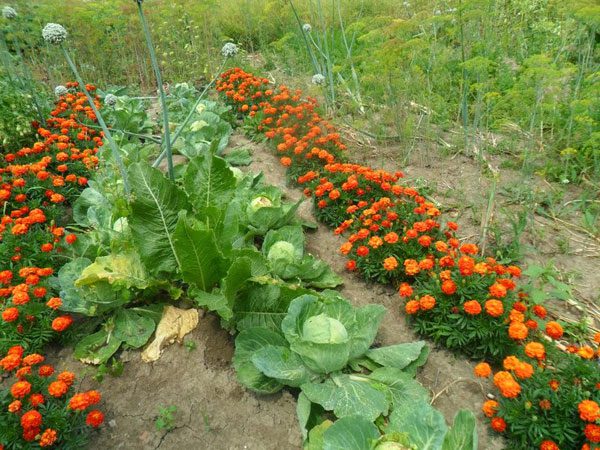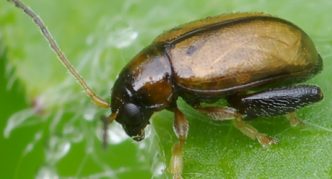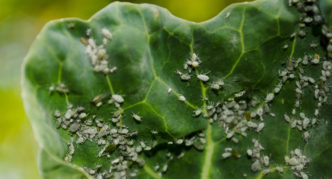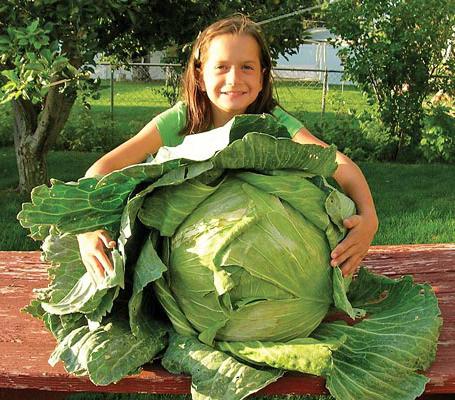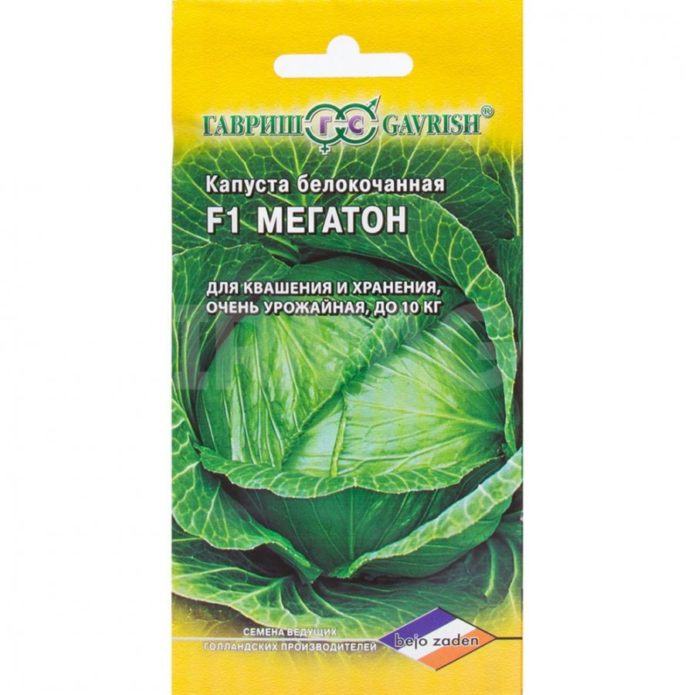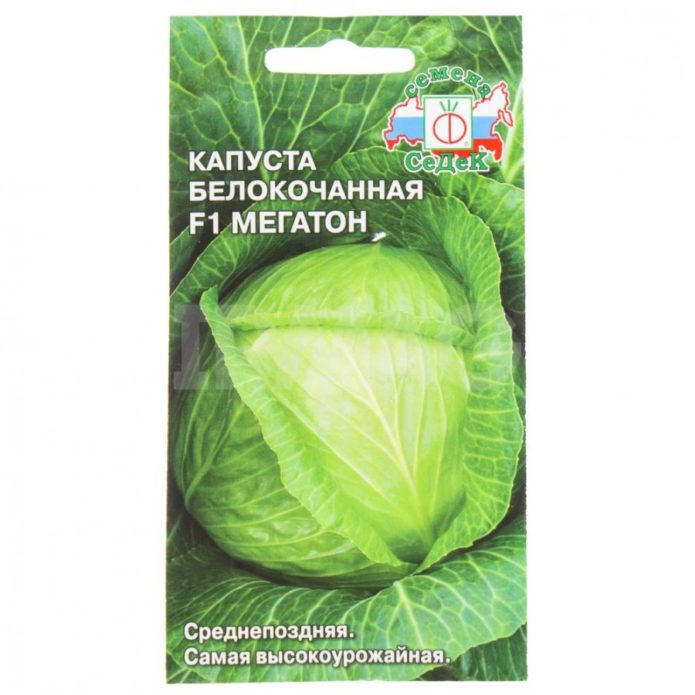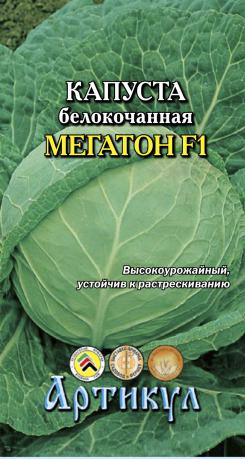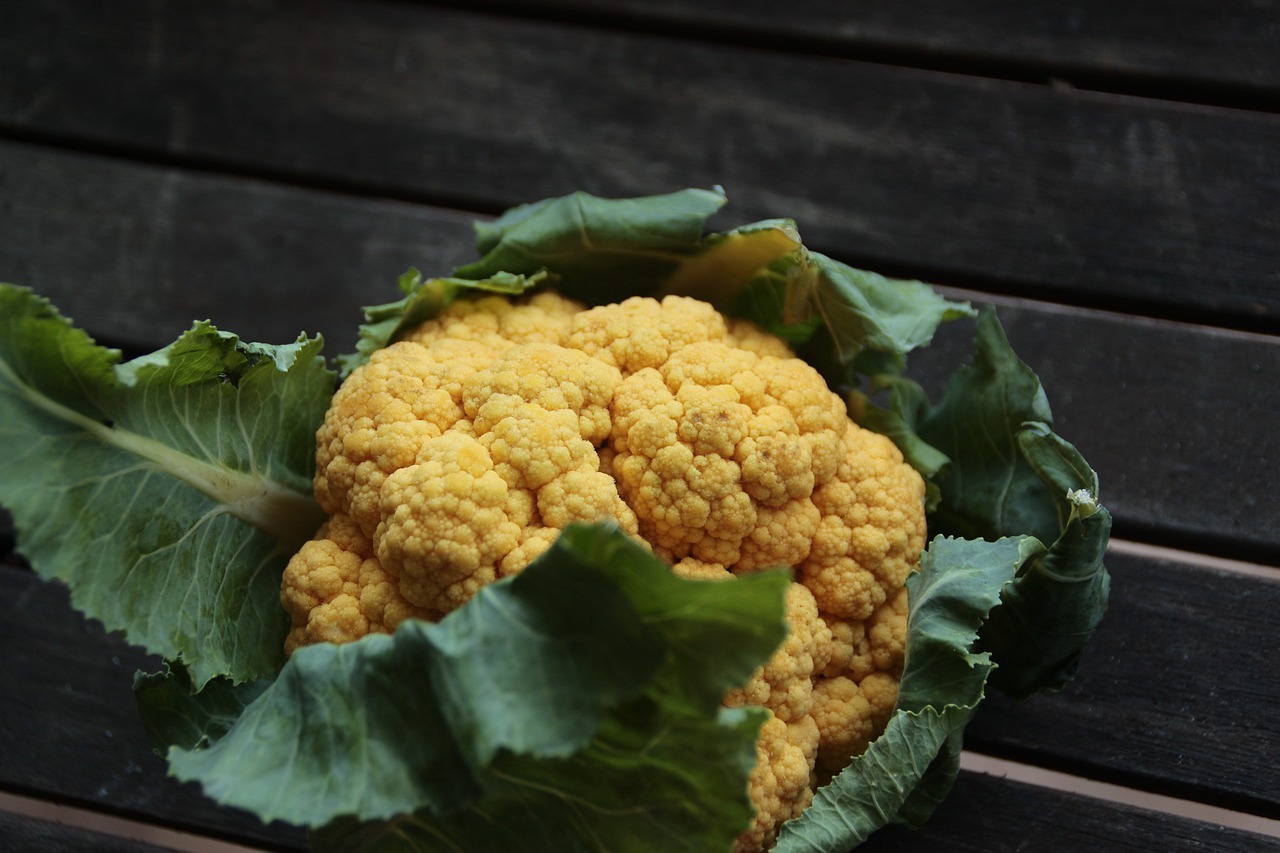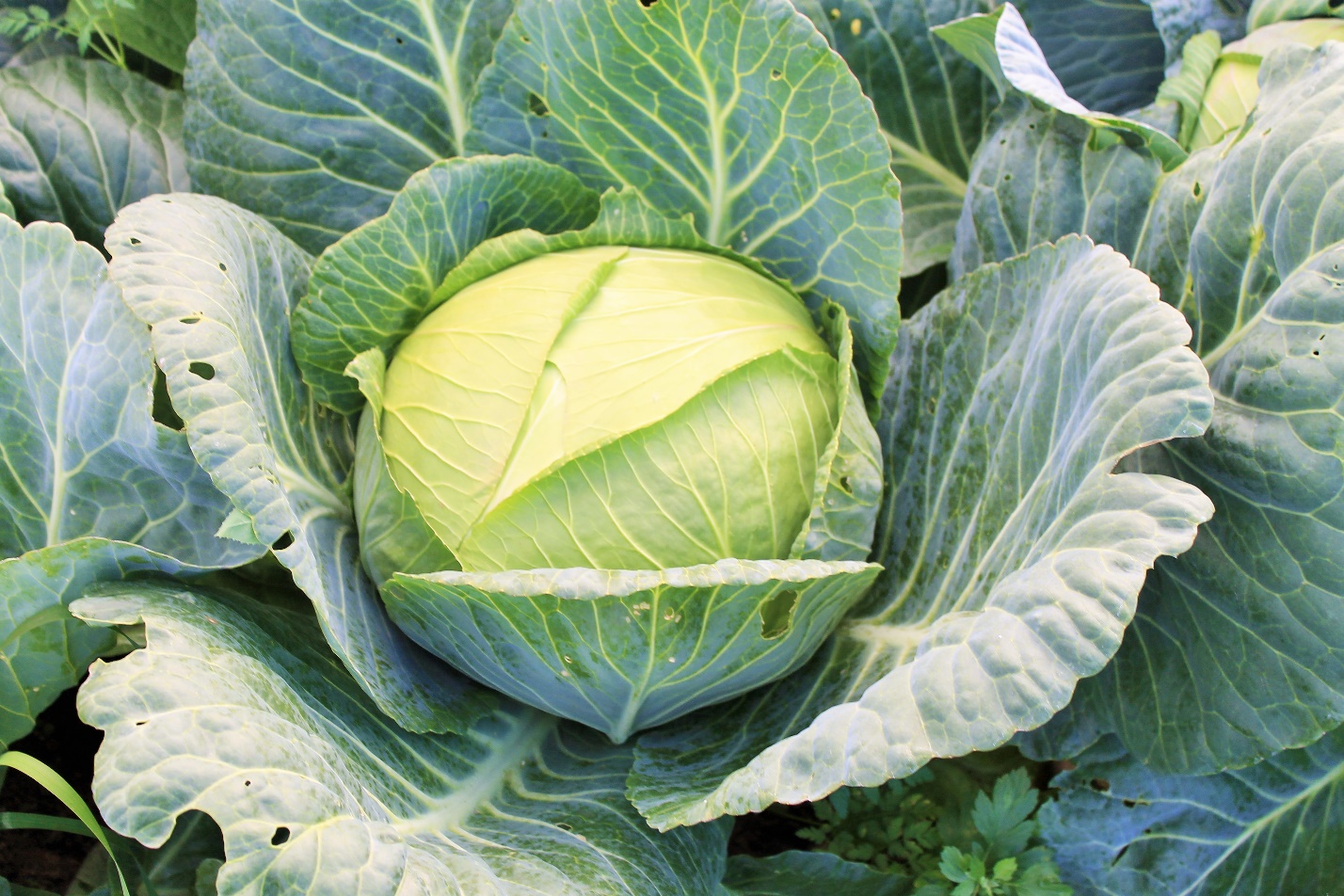White cabbage has long been cultivated in private plots. It is unpretentious in care, and due to its excellent taste it is widely used in cooking. Mid-season cabbage Megaton is considered the best variety for pickling and pickling - dense leaves do not sour in brine, remain elastic and crispy when stored in jars and barrels.
Content
Description and characteristics of Megaton cabbage
The Megaton variety is an achievement of the Dutch specialists. This hybrid was obtained in the seed company Bejo Zader, one of the leaders in the world of breeding. In 1996, it was introduced into the State Register of Russia and is recommended for cultivation in most of the country, with the exception of the Middle Volga region.
White cabbage Megaton received recognition from gardeners for its unprecedented yield - 586-934 centners per hectare can be harvested, which exceeds the standard indicators of the Podarok and Slava Gribovskaya 231 varieties by 91-147 centners / ha. And with good weather conditions and proper care, you can reach a record - the maximum yield of the hybrid is 1053 c / ha, 361 c / ha higher than the Amager 611 standard (Moscow region).
The variety is medium late, ripens on the 136-168th day after germination, when grown through seedlings, you can harvest in September already. By this time, forks are formed with an average weight of 3.2-4.1 kg, with a maximum weight of about 15 kg... Rounded light green leaves with a waxy coating, wavy at the edges, forming a large semi-raised rosette. The head of cabbage is dense, round, semi-covered, smooth, with a short inner stump.
Megaton cabbage is also valued for its excellent taste. Juicy and crispy leaves can be eaten fresh, but due to the presence of a large amount of sugars, they are not suitable for making stuffed cabbage rolls. But Megaton is the number one cabbage for pickling.
The variety is immune to fusarium, moderately resistant to gray rot and keel. As a disadvantage, they note the short shelf life of fresh cabbage - no more than 3 months.
Video: Megaton cabbage
Features of growing cabbage
Megaton cabbage is grown through seedlings or by sowing in open ground.
Seedless way
Cabbage can be sown immediately in the garden to a permanent place. In late April - early May, when the heat is established (+ 15 ° C), and the soil warms up enough, the site is loosened, humus is introduced (10 kg / m2) and complex fertilizer (45 g), spill with a hot solution of potassium permanganate and sow dry seeds into the marked grooves to a depth of 1 cm. Place 4-5 seeds in each hole. Sowing is carried out according to the scheme 70x45 cm.
Before the first shoots appear, the soil should be moistened with a sprinkler. If sowing is carried out in cold soil, the seeds will not germinate for a long time and will begin to swell only at a temperature of 5 ° C. The warmer the environment, the faster the seeds germinate: at 20 ° C sprouts appear in 4–5 days, at 10 ° C - much later, after 10–14 days.
The crops are covered with foil or agrofibre on arcs. Plastic bottles without a bottom, cans are used as insulation. In a warm time of the day, you should remove the shelter for ventilation.
When the first leaf appears, watering is carried out and dense plantings are thinned, leaving 2 stronger seedlings in the holes. After the appearance of 4 leaves, a second thinning is carried out, a weaker sprout is removed. Since frosts are possible in Siberia and the Urals even at the beginning of June, the shelter from the garden is removed only after the threat of return cold has passed.
With the seedless method, cabbage grows stronger, more resistant to adverse weather conditions, but the harvest ripens later - 136-168 days after germination.
Video: a method of sowing cabbage in the ground
Seedling method
The seedling method allows you to reduce the growing season to 115 days, but it requires more time and effort from the gardener.
Sowing seedlings
Sowing of Megaton cabbage seedlings is carried out from the second half of March to the 20th of April. Seeds are germinated in separate cups without picking or in seedling boxes followed by picking into pots.
Previously, seeds that do not have a protective shell are disinfected in a solution of potassium permanganate, then exposed to contrasting temperatures: they are immersed in hot (50 ° C) water for 15 minutes, then kept in a refrigerator for a day (1-2 ° C). The hardened seeds are dried to a free-flowing state, then they are sown.
- The containers are filled with a ready-made commercial substrate or a nutrient mixture from turf soil, humus and sand (1: 1: 1).
- The prepared soil mixture is preliminarily disinfected with Fitosporin solution.
- Sowing is carried out in rows according to the scheme 1x3 cm to a depth of 1 cm, 2-3 seeds are placed in individual cups each.
- The seeds are sprinkled with earth, moistened with a spray bottle and covered with foil.
- Until the emergence of shoots, the containers are kept indoors at a temperature of 20-25 ° C.
- The sprouts appear quickly - after 4–5 days, when grown in a common box, they must be thinned out, increasing the distance between them to 2 cm, and only 1 strong sprout should be left in the cup.
- Then, for a week, the seedlings are transferred to a cooler place (10–12 ° C), watering with warm water when the topsoil dries up.
- In the future, the optimum temperature regime for the seedlings is set - 20–22 ° С.
- For seedlings, it is necessary to provide good diffused lighting; phytolamps can be used if necessary.
It is advisable to sow seeds for seedlings in several stages in order to replace weak seedlings in the garden if necessary, and also to be able to harvest as long as possible.
Seedling picking
With the opening of the 3rd true leaf, the seedlings are picked from the seedling boxes into individual pots. Previously, the cabbage is well moistened and removed along with a lump of earth. In a new container, the seedlings are buried at the level of the cotyledon leaves.
Top dressing of seedlings
During the seedling period, cabbage is fed three times:
- after the opening of the 1st sheet (12 g of ammonium nitrate, 20 g of superphosphate, 5 g of potassium salt \ 5 l);
- a week later (liquid mullein or ammonium nitrate solution - 15 g \ 5 l);
- 2 days before planting in the ground (15 g of ammonium nitrate, 10 g of potassium salt and 40 g of superphosphate \ 5 l).
Hardening cabbage
A week before transplanting, the seedlings are taught to new conditions: first, the vents are opened, then they are taken out to the glazed loggia for several hours, and then into the garden. Pampered seedlings can die even with a slight cold snap, and hardened seedlings will withstand frosts down to -3 ° C.
Planting seedlings in the ground
Seedlings are planted in the ground at the age of 45-50 days. By this time they should have a strong stem 10–12 cm high and 3 pairs of true leaves. If the spring is protracted, it is worth postponing the transplant until warming.
For cabbage, choose a well-lit area - in a shaded place, the head of cabbage is formed less dense, with small leaves. Mid-season varieties grow best on sandy loam or loamy soil after pumpkins, squash, potatoes, carrots, onions, beans and peas. On the beds where cruciferous crops used to grow, cabbage can be planted only after 3-4 years in order to reduce the risk of damage to its keel - fungal spores remain in the soil for a long time.
Landing scheme
The site should be prepared in the fall: dig up and add 10 kg of humus. Cabbage develops very poorly on acidic soil, therefore, lime must be added to reduce acidity (500 g / m22). In the spring, the loosened soil is fertilized with urea (30 g) and ash (500 g / m22), mark the grooves with an interval of 60 cm and make holes every 45 cm, into which 15 g of superphosphate are placed and 500 ml of water are poured. One seedling is planted in each hole, sprinkling to cotyledon leaves.
At first, young cabbage is covered with non-woven material so that the bright sun or nighttime cold snaps do not destroy it. Strong plants quickly adapt to a new place, and weak sprouts are best removed and planted with healthy seedlings.
Video: how to properly plant cabbage seedlings in open ground
How to care for cabbage outdoors
The harvest will depend on leaving. Therefore, the entire growing season must be moistened and loosened in the cabbage bed, fertilized and treated against diseases and pests.
Watering and loosening
Cabbage loves moisture - in the absence of watering in hot weather, the leaves become dry and lethargic. Watering it begins on the third day after planting in the ground, bringing in 8 liters of water / m2 after 2–3 days. After 2 weeks, the number of watering is reduced to 1 time in 7 days, while consuming more water - 12 l / m2... In extreme heat, cabbage leaves must be irrigated from a watering can. It is better to do this early in the morning or in the evening, protecting wet foliage from burns under the scorching rays of the sun. In a rainy summer, watering is reduced - stagnant water in the soil often leads to root rot. During the laying of the forks, water is applied only at the root, and 2 weeks before harvesting, watering is stopped so as not to cause cracking of the heads.
There are several ways to water cabbage:
- on level ground, water is brought from a bucket into grooves, which are made in the aisles to a depth of 10 cm. After watering, the grooves must be sealed;
- on areas with any relief, sprinkling can be used, in which water is sprayed over the plants from a hose with a spray or a watering can. However, during the formation of the heads, this irrigation method is not suitable;
- the most effective method is drip irrigation.Through pipes laid along the rows of cabbage, water is supplied under pressure and through the holes it flows directly to the plants. This irrigation option is very economical and greatly facilitates the work of farmers, especially in large areas.
The moist soil must be loosened to a depth of 7 cm so that a soil crust does not form, which prevents air from reaching the roots. After 3 weeks after planting the seedlings, the first hilling is carried out, after 10 days they are hilled again. Such agricultural practice contributes to the formation of additional roots, which subsequently has a positive effect on the quality of the crop.
Top dressing
The need for nutrients depends on the age of the cabbage. At the initial stage of growing, it needs nitrogen, during the formation of heads of cabbage, the need for phosphorus and especially potassium increases.
Experienced gardeners, by the appearance of plants, can easily identify the lack of nutrients in them. Thin and sluggish shoots, stunted growth indicate a nitrogen deficiency at the early development stage. A sign of a lack of phosphorus is a change in the color of the leaves from green to purple. An insufficient amount of potassium leads to a marginal burn of the leaf.
When the first true leaf is opened, cabbage sown directly to the garden is fed with a solution of ammonium nitrate (20 g / 10 l), Agricola (25 g / 10 l). After 2 weeks, a liquid suspension of chlorella (1 l / 10 l) is introduced into the soil.
After the formation of 6 true leaves, cabbage in the garden is fertilized with a nitrogen composition - mullein infusion (1:10) or urea (30 g / m22) to strengthen the root system and quickly build up leaf mass. When laying the forks, Azofoska (50 g / m22), Nitroammofosku (30 g / m2).
An ideal replacement for mineral fertilizers is herbal infusion. Nettle, dandelion, burdock, yarrow, woodlice, shepherd's bag in a crushed form are placed in a barrel, filling it in 3/4 parts, poured with water, covered with a lid and put to fermentation. After 5 days, the finished infusion is filtered, diluted with water 1:10 and brought to the garden. They begin to feed the cabbage with this infusion 2 weeks after planting the seedlings and fertilize it every 14 days over the next 2 months.
Video: growing cabbage
Protection against diseases and pests
Megaton cabbage is resistant to fusarium wilt, but when growing, gardeners sometimes encounter other diseases, the causes of which may be bad weather conditions or violations of agricultural technology.
Table: common cabbage diseases
| Name of the disease | Symptoms | Preventive measures | Treatment |
| Keela | Seedlings lag behind in development, do not take root well after transplanting to the garden, the lower leaves dry out, growths form on the roots. |
|
|
| Peronosporosis | Young cabbage is especially susceptible to disease in hot weather. Darkish spots appear on the upper side of the leaf, a grayish coating spreads from the lower part of the leaf plate. | Regulate watering, avoid waterlogging. |
|
| Blackleg | The stem of the seedling in the root part darkens and rots. The plant dies. |
|
|
Photo gallery: cabbage diseases
- The formation of growths on the roots of cabbage is a sign of the development of a keel
- With peronosporosis, a grayish bloom appears on the underside of the cabbage leaf
- Black leg can kill all seedlings
Table: pests threatening cabbage
| Pests | Manifestations | Prevention | Measures |
| Cruciferous flea | The parasites feed on the pulp of the leaves. They prefer to settle on young plants. If you do not fight them, the seedlings can completely die. |
|
|
| Aphid | Small insects are especially fond of the juicy leaves of young cabbage. Aphid colonies literally stick around the plants and, sucking out the juice, greatly weaken them. |
|
|
| Cabbage white | Caterpillars feed on juicy leaves, eating them around the edges; in case of a large accumulation, they can destroy the flesh of the head of cabbage. Leaf-eating pests not only impair the presentation of the vegetable, but also reduce its taste. | Carefully examine the cabbage leaves and destroy the eggs that the female has laid. |
|
Photo gallery: cabbage pests
- Cabbage whites hatch eggs on the leaves, from which larvae develop, causing great harm to plants
- The cruciferous flea makes holes in the leaves, feeding on juicy pulp
- Mass accumulation of aphids on cabbage leaves is observed in dry hot weather.
Video: how to deal with a cruciferous flea
Harvesting
The Megaton cabbage harvest ripens in September. Loose heads of cabbage can be used for fermentation, and more dense ones can be transferred to the basement for storage. Place the forks on the shelves on a layer of dry straw. Vegetables will keep well for 3 months in a humid room with a temperature of 1-2 ° C.
Video: Megaton cabbage harvest
Megaton cabbage seeds - the best producers
Of course, when choosing seeds, gardeners prefer well-known brands. However, the list of agrofirms is constantly changing, and in the face of fierce competition, young companies, taking care of their own reputation, must control germination, disease resistance, update seed collections, use the experience of domestic breeding and the achievements of foreign colleagues.
The leader in seed production is the Gavrish agricultural company. The company, which has been supplying seed to the domestic market for more than 20 years, has an excellent reputation. After all, the quality of seeds is carefully checked before packing in sachets; during storage, germination and germination energy are periodically determined.
SeDec is the oldest company on the Russian seed market.Since 1995, she has been engaged in varietal selection and seed production. High-quality seed material of the agricultural firm "SeDec" is used by farmers not only in our country, but also by foreign experts. The agrofirm cooperates with leading domestic breeders and seed companies in many countries of the world. Every year, more than 2,000 varieties of various crops are tested here in protected and open ground on a 40-hectare experimental plot in the Moscow region, as well as in many regions of Russia with different climatic conditions, which is an additional guarantee of high quality seeds.
The company "Prestige" has also proved itself to be excellent, presenting on the Russian market seeds of leading foreign producers from Japan, Holland, Germany and Italy, as well as achievements of domestic breeding. All seeds must be certified in Russia and are suitable for our climatic conditions. By purchasing Megaton cabbage seeds of the Prestige trademark, there is no doubt that the harvest will be rich, because for many years the company has been selling excellent raw material for the production of vegetables.
The Seeds for Siberia company has been on the seed market since 1996. She specializes in the packaging and sale of vegetable and flower crops. Its assortment also includes the best domestic seed producers.
Since 1993 the company "New Seeds" has been known to vegetable growers in the Urals. The firm works with Dutch, Japanese vegetable seed producers and domestic breeders. Throughout the entire growing period - from sowing to harvesting and storage - the company provides consulting on the production of agricultural products.
The company "Aquarelle", founded in 2003, is engaged in the sale of Dutch seeds. The company offers over 150 types of vegetables and 300 varieties of flowers. Seed germination is strictly controlled here and at the output is close to 100%. Due to the high quality of seed material, it is readily purchased by farms and agricultural complexes.
Agrofirm "Artikul" has been producing and selling seeds since 1990. And if in the early 2000s, non-varietal seeds were often found in bags, nowadays there are practically no defective lots.
Seeds of the PLAZMAS trademark are in great demand among gardeners. The company supplies the market with plasma-treated seed material. This technology was developed by St. Petersburg scientists by placing seeds in a gaseous medium under reduced pressure. When the seeds are exposed to low-temperature plasma, life processes are stimulated, as a result, their germination is accelerated, the quality and quantity of the crop improves. Plasma seeds help out in dry summers: ordinary crops die, but these - grow perfectly. These seeds are ideal for high-risk farming areas.
Reviews
We have been planting Megaton cabbage for several years already specifically for storage. We keep it in the basement of the garage until May. Does not burst. We eat it fresh, with salads and a little sour, in jars. If we don't eat everything, then in May we will take it to the village with us. Great cabbage. This is Slava, if he sits out on the garden bed, then it bursts and sprouts immediately. Glory is poorly stored, but tasty when fermented. Glory is looser and whiter, worse stored. Megaton is very dense, suitable for long-term storage and fermentation.
I discovered this variety for myself in 2010.Even with an abnormally hot summer, the variety was a success. There were ten seeds in the bag, and all ten sprout. I have not seen pests on cabbage. When planting, I added a handful of ash, superphosphate and manure to each hole. Every day she loosened, weeded, watered. Of the ten pieces, one weighed eight kilograms, the rest were smaller. Not a single head of cabbage cracked. Cabbage is good for leavening. It turned out juicy.
Cabbage Megaton F1 is a very good cabbage. Heads of cabbage are large, dense, do not burst. I have been buying the seeds of this cabbage for 7 years. Since I live in Siberia, not all varieties are suitable for growing in our climatic conditions, and Megaton is great. It is hardy, mid-season. I plant it at the end of March - at the beginning of April for seedlings, and at the end of April I plant it on the ground, only for the first time I cover it with acrylic. You have to tinker a little, but already at the beginning of August, cabbage pleases with its huge heads. Her taste is very pleasant, suitable for salads, and for fermentation, and for pies. My children love to eat it fresh.
Cabbage Megaton is a hybrid created by Dutch breeders with improved characteristics. This is the most productive variety of white cabbage with high palatability, retaining its presentation during transportation, and resistant to pathogens. It is no coincidence that gardeners who grow this vegetable on their plots are unanimous in their opinion - Megaton is a super cabbage.

